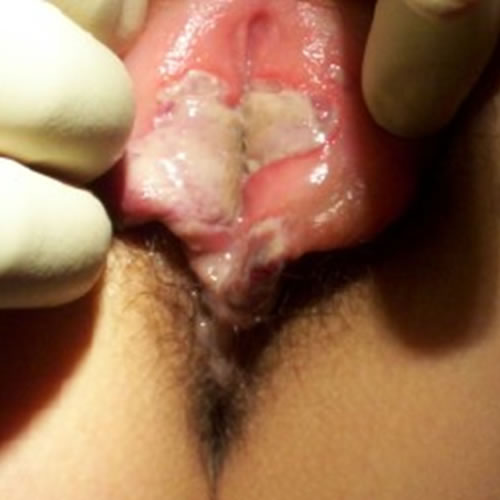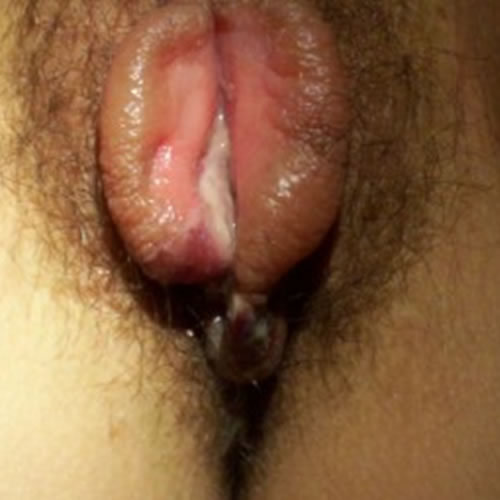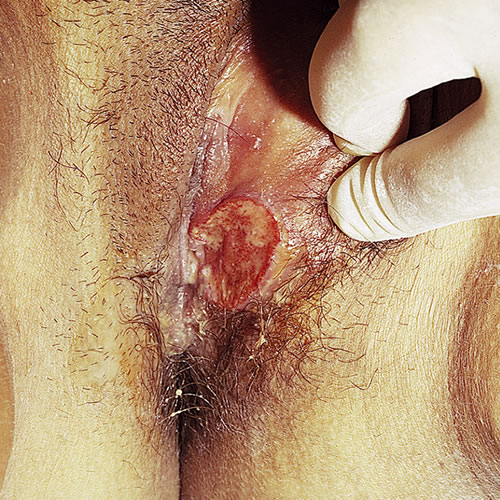Introduction
Aphthous ulcers are the equivalent of oral canker sores present on the vulva: acute painful ulcers of sudden onset. Recurrent genital and oral ulceration in women without other systemic manifestations of Behçet disease (arthritis, iritis, pathergy, and neurologic disease) or any other disease, is referred to as complex aphthosis.1 Oral ulcers alone represent simple aphthosis. Complex aphthosis with acute, reactive ulcers (trigger unknown), is particularly common in young women. Young persons who have never been sexually active are put through costly and emotionally charged evaluations for these lesions that have non-sexually transmitted etiologies.
Synonyms include aphthous ulcers, canker sores on the vulva, aphthous stomatitis, Lipschütz ulcers, ulcus vulvae acutum, acute genital ulcers (AGU), and reactive, non-sexually related, acute genital ulceration (RNSRAGU)
Epidemiology
The true incidence is unknown. Simple aphthosis is extremely common, affecting 30-66% of adults with rates highest in whites and adolescents.2 Complex aphthosis is thought to be rare. The numerous synonyms point to the probability that Lipschütz ulcers and the other acute, non-sexually related genital ulcers, especially when they occur in young women and girls under the age of 25, are the same entity.
Etiology
The cause of aphthous ulcers, simple or complex is unknown. It is suggested that they are inflammatory disorders triggered by exogenous factors3 in genetically susceptible individuals. One hypothesis is that microbial antigens, by way of molecular mimicry, induce an auto-reactive (autoimmune) process. Stress, infections, vitamin deficiency, and family history are considered risk factors. RNSRAGU often occurs after an acute systemic infection: viral gastroenteritis, viral upper respiratory tract infection, streptococcal pharyngitis, influenza or nonspecific febrile illness.4 There are a few recent case reports of adolescents and young women presenting with aphthous ulcers following Pfizer BioN-Tech (BNT162b2) Covid-19 vaccine5 6 or Covid-19 infection.7
Symptoms and clinical features
Many women present with fever, malaise, and oral aphthae. The main vulvar symptom is pain from the ulcerations.
A punched-out, shallow, well-defined ulcer with a fibrinous (yellow-white) base and somewhat erythematous border is observed.


The ulcers may be single or in groups (“herpetiform”), located around the vulvar vestibule and occasionally on the outer labia minora, the labia majora, the perineum, and the introitus. They can range in size from 1-2 cm with a depth of 1 cm in the vestibule while the oral lesions are smaller (2-5 mm).8 They are usually round in shape, but the larger ulcers can be irregular in shape with deep, reddish bases.9 Occasionally a large, deep, punched-out, destructive (giant) aphthous ulcer develops, often from merging of one ulcer with another.

The usual duration of the ulcers is one to three weeks, but they can persist for months. The large ulcers usually heal with scarring.10
A retrospective analysis of 110 women with vulvar ulcers was performed at a clinic during a five year period. 34 (30.9%) had a diagnosis of Lipshutz ulcers. The mean age was 29.8 years (10-79 years). Ten (29.4%) were 35 years old or more. The majority of patients had already had their sexual debut. Ten (29.4%) had at least one previous similar episode. Twenty-five (72.5%) had non-gynecological symptoms in the week before; the most common were: odynophagia (38.2%), fever (32.3%), myalgia and upper or lower respiratory tract infection (17.6%). The ulcers were located most frequently in the vestibule (58.8%) and the labia minora (29.4%), with 82.3% on the right side. Multiple lesions (64.7%) were more common than a single lesion. The mean time to full healing of the lesions was 15.6 days. A microbiological probable cause was identified in 29.4%: cytomegalovirus (CMV) in four cases, Mycoplasma pneumonia in three cases, Epstein-Barr (EBV) in two cases, and parvovirus B 19 in one case.11
Diagnosis
Diagnosis is by exclusion, following appropriate biopsies and cultures to rule out other conditions. It is not uncommon for all testing to be negative. See table below. Herpes simplex (types 1 and 2) must always be ruled out by culture and titer, but many young women who have never been sexually active have been challenged and dismayed by their health care provider’s implication that they are lying and insistence that herpes must be present.
Pathology/laboratory findings
Testing is directed at ruling out systemic disease or diagnosing sexually transmitted diseases, if appropriate.
Tests to evaluate vulvar ulcers12
| TEST | RATIONAL FOR TEST |
|---|---|
| HSV (herpes simplex 1 and 2) culture or PCR (higher sensitivity), and serology | Essential to rule out herpes. |
| Testing for syphilis, chancroid, LGV | May be considered depending on demographic probability and symptoms. Primary syphilis is usually painless; chancroid and LGV are accompanied by lymphadenopathy. |
| CBC to test for anemia, neutropenia, or thrombocytopenia | May be considered if systemic conditions such as Crohn disease or lupus are possible. Rarely, cyclic neutropenia, MAGIC syndrome, PFAPA syndrome, and folate deficiency may cause vulvar ulcers, which have also occurred with viral illnesses and other systemic conditions. |
| Serologic testing for EBV (Epstein-Barr virus) and, occasionally CMV (cytomegalovirus) | Antibodies may be present but relationship to aphthosis is unclear and controversial.13 Test if knowing would be helpful. |
| HIV | Genital ulcers may occur with HIV. Test depending on history, local prevalence, and index of suspicion. |
| Iron, folate, Vitamin B 12 levels | If folate deficiency is suspected. |
| Tissue Transglutaminase (tTG) Antibody, IgA, Gliadin Antibody, IgA, Endomysial Antibody (EMA) Screen, IgA- performed (at additional charge) when the anti-tTG IgA is positive, EMA Titer-performed (at additional charge) when the EMA screen is positive, tTG Antibody, IgG-performed (at additional charge) when total IgA is low | If gluten sensitivity is suspected. |
| Biopsy of the edge of the ulcer | Biopsy is helpful mostly in ruling out other conditions, but may, with apthosis, show only non-diagnostic acute and chronic inflammation and necrosis without vasculitis.14 15 |
| Further testing for Crohn disease, Behçet disease, PFAPA syndrome, MAGIC syndrome and folate deficiency if any of these are suspected. | May be done. |
| Drug reaction should be suspected by history and elimination of the drug having an effect. | Cytotoxic drugs and NSAIDS are sometimes involved. |
Differential diagnosis
The differential diagnosis includes sexually transmitted (HSV, syphilis, chancroid, LGV, HIV), and non-sexually transmitted infections (EBV, Mycoplasma pneumonia), non-bullous dermatoses (Behçet disease, lichen planus, lichen sclerosus, Crohn disease, contact dermatitis, pemphigus, pemphigoid, and drug reaction) and tumor (squamous cell carcinoma). Other associated infections, usually in acute aphthosis, may be viral upper respiratory tract infections (Parvovirus, influenza paramyxovirus) and gastroenteritis (salmonella), toxoplasmosis, gondii, streptococcus infection, mumps, and Lyme disease. As noted above, there have been a few case reports of vulvar aphthous ulcers following administration of Pfizer-BioNTech (BNT 162b2) Covid-19 vaccine16 17 or following a Covid-19 infection.18
With time, the older patients with recurrent ulcers may develop Behçet disease (very rare in North America) or inflammatory bowel disease, or these may become apparent at varying intervals after the initial presentation of the aphthae. Also associated with aphthae are the myeloproliferative diseases, especially those with neutropenia and lymphopenia, and HIV. Three syndromes associated with aphthae are Sweets syndrome, PFAPA (periodic fever, aphthae, pharyngitis, adenitis) and MAGIC syndrome: mouth and genital ulcers with inflamed cartilage.19
Treatment/management
Treatment is aimed at controlling pain, promoting healing, and preventing scarring. If systemic disease is suspected, referral to gastroenterology, neurology, rheumatology, and ophthamology is appropriate. Educate the patient, informing her that genital aphthosis is often a one-time event; recurrences can be controlled. It is helpful to refer to the ulcers as being “like canker sores.” Follow up is important to be sure of the efficacy of treatment, for further education of the patient, and to confirm the diagnosis and plan for the future.
Treatment of aphthosis
| Treatment action | Topical | Oral | Intralesional |
|---|---|---|---|
| Comfort measures/general care: Sitz bath, gentle cleansing, avoidance of irritants or tight clothing | Pain relief Topical xylocaine 5%, applied as needed, usually 4-6 times a day | Naproxen sodium 550 mg twice a day for the acute phase Oxycodone/Acetaminophen 5/325 mg 1-2 tabs every 4-6 hrs for severe pain |
|
| Abbreviation of outbreak in the mouth | Amlexanox 5% paste, applied four times a day in the mouth | ||
| Anti-inflammatory action | Clobetasol or halobetasol 0.05% ointment (for the vulva) or gel (for the mouth) in a thin film twice a day, tapering with improvement (7-10 days) | Prednisone or methylprednisolone 40-60 mg every morning for 5 days, or tapering dose up to 7-10 days | Triamcinolone acetonide (Kenalog 10), 10 mg/mL diluted 1:1 with saline and using a 30-gauge needle injected under ulcer after application of EMLA (for large, painful, or unresponsive lesions) |
| To abort an outbreak | Colchicine 0.6 mg twice daily on an ongoing basis to prevent or promptly abort lesions OR Prednisone 30 mg daily for 3-4 days to abort lesions |
||
| Antibiotics for superimposed infection and suppression | Cephalosporins or sulfonamides for broad-spectrum effect x 7-10 days OR Doxycycline 50-100 mg twice a day for suppression20 |
One author mentions the use of topical sucralfate in the treatment of aphthae. Because we do not have experience with this medication, we have not included it above.21
Treatment of complex aphthosis where lesions are frequently recurrent, almost constantly present, and/or occurring in both the oral cavity and the genital area will be beyond the purview of the general woman’s health practitioner. Two important studies 22 23 reflect the value of using colchinine, Dapsone (after testing for G6PD), a combination of the two medications, or Thalidomide in treatment.
References
- McCarty MA, Garton RA, Jorizzo JL. Complex aphthosis and Behcet’s disease. Dermatol Clin. 2003; 21(1):41-48
- Shulman JD. An exploration of pain, annual, and lifetime prevalence in characterizing recurrent aphthous stomatitis in USA children and youths. J Oral Pathol Med. 2004; 33:558-66.
- Zunt SL. Recurrent aphthous stomatitis. Dermatol Clin. 2003; 21(1):33-39.
- Lehman JS, Bruce AJ, Wetter DA, Ferguson SB, Rogers RS 3rd. Reactive nonsexually related acute genital ulcers: review of cases evaluated at Mayo clinic. J Am Acad Dermatol 2010; 63(1):44-51.
- Drucker A, Corrao K, Gandy M. Vulvar aphthous ulcer following Pfizer-BioNTech COVID-19 vaccine-a case report. J Pediatr Adolesc Gynecol.2022; 35(2):165-6
- Wojcicki A, O’BrienK. Vulvar aphthous ulcer in an adolescent after Pfizer-BioNTech(BNT162b2) COVID-19 vaccination. J Pediatr Adolesc Gynecol 2022 Apr;35(2):167-170.
- Christl J, Alaniz VI, Appiah L, Buyers E, Scott S, Huguelet PS. Vulvar aphthous ulcer in an adolescent with COVID-19. J Pediatr Adolesc Gynecol 2021: 34:418-420.
- Edwards L and Lynch P. Genital Dermatology Atlas, 3rd edition. Wolters Kluwer/Lippincott Williams & Wilkins. Philadelphia, 2018. 224.
- Edwards L and Lynch P. Genital Dermatology Atlas, 3rd edition. Wolters Kluwer/Lippincott Williams & Wilkins. Philadelphia, 2018. 224.
- Edwards L and Lynch P. Genital Dermatology Atlas, 3rd edition. Wolters Kluwer/Lippincott Williams & Wilkins. Philadelphia, 2018. 224.
- Vieria-Baptista P, Lima-Silva S, Beires J, de-Oliveira J. Lipschutz ulcers; should we rethink it? An analysis of 34 cases. Presented at the XXIII World Congress of the International Society for the Study of Vulvovaginal Disease, July 27-29, 2015, New York University, New York City, NY.
- Huppert JS. Lipschutz ulcers: evaluation and management of acute genital ulcers in women. Dermatologic therapy. 24 Sept 2010. 23 (5). 538.
- Edwards L and Lynch P. Genital Dermatology Atlas, 3rd edition. Wolters Kluwer/Lippincott Williams & Wilkins. Philadelphia, 2018. 224.
- Mimura MAM, Hirota SK, Sugaya NN, et al. Systemic treatment in severe cases of recurrent aphthous stomatitis: an open trial. Clinics (Sao Paulo). 2009; 64(3): 193-198.
- Edwards L and Lynch P. Genital Dermatology Atlas, 3rd edition. Wolters Kluwer/Lippincott Williams & Wilkins. Philadelphia, 2018. 225.
- Drucker A, Corrao K, Gandy M. Vulvar aphthous ulcer following Pfizer-BioNTech COVID-19 vaccine-a case report. J Pediatr Adolesc Gynecol.2022; 35(2):165-6
- Wojcicki A, O’BrienK. Vulvar aphthous ulcer in an adolescent after Pfizer-BioNTech(BNT162b2) COVID-19 vaccination. J Pediatr Adolesc Gynecol 2022 Apr;35(2):167-170.
- Christl J, Alaniz VI, Appiah L, Buyers E, Scott S, Huguelet PS. Vulvar aphthous ulcer in an adolescent with COVID-19. J Pediatr Adolesc Gynecol 2021: 34:418-420.
- Akintoye SO, Greenberg MS. Recurrent aphthous stomatitis. Dent Clin North Am. 2014;58:281-297.
- Management of nonsexually acquired genital ulceration using oral and topical corticosteroids followed by doxycycline prophylaxis. Dixit S, Bradford J, Fischer G. J Am Acad Dermatol. 2013 May; 68(5): 797-802.
- Bandow GD. Diagnosis and management of vulvar ulcers in Edwards L, guest editor, Vulvovaginal Dermatology in Dermatologic Clinics, October, 2010. Vol 28; No 4. 753-758.
- Letsinger JA, McCarty MA, Jorizzo JL. Complex aphthosis: a large case series with evaluation algorithm and therapeutic ladder from topical to thalidomide. J Am Acad Dermatol. 2005; 52:500-508.
- Mimura MAM, Hirota SK, Sugaya NN, et al. Systemic treatment in severe cases of recurrent aphthous stomatitis: an open trial. Clinics (Sao Paulo). 2009; 64(3): 193-198.